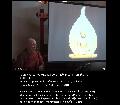The initial meditation instructions in the Girimananda Sutta are
deceptively simple. As the Buddha explained to Ananda, in mindful-
ness of breathing, the meditator does the following :
Here, a bhikkhu, having gone to the forest, to the foot
of a tree, or to an empty hut, sits down. Having folded his legs
crosswise, straightened his body, and established mindful- ness
in front of him, just mindful he breathes in, mindful he
breathes out.
Breathing in long, he knows: ‘I breathe in long’; or
breathing out long, he knows: ‘I breathe out long.’ Breath- ing
in short, he knows: ‘I breathe in short’; or breathing out
short, he knows: ‘I breathe out short.’ (tr. Bhikkhu Bodhi)
▶ Go to a quiet place. Though the Buddha suggested a
forest, the foot of a tree, or an empty abode, for us, the place
simply needs to be somewhere we can be alone, away from everyday
concerns. It will not help us to develop concentration if we
take our mobile phone or laptop along! In order to focus our
attention, we need to avoid distractions, both inner and outer.
▶ Adopt a stable and comfortable posture. The Buddha
recom- mended sitting down, folding the legs, and straightening
the back. Many people today practice meditation while sitting
cross- legged on the floor, supported by a low cushion. But it
is also pos- sible to meditate while sitting upright in a chair,
or even, when circumstances make it preferable, while standing
up, walking, or lying down. The goal is for the body to be
settled and relaxed, and for the posture to be one we can easily
sustain for an extended period of time without shifting or
readjusting.
▶ Bring attention to the present moment. As the Buddha
expressed this guideline, we should set up mindfulness “in
front.” We follow this instruction by remembering that the past
is gone and the future has not yet arrived. The only time we can
be truly present is right in front of us, the moment that is
happening now.
▶ Focus the mind on the breath, coming in and going out.
A sin- gle point of focus helps the mind to settle down. The
best place to experience the movement of the breath is the spot
where the flow of air touches or rubs the rim of the nostrils
during inhalation and exhalation.
▶ Become aware that sometimes the breath is long, and
other times it is short. This instruction does not mean that
we should try to control our breathing , forcing ourselves to
take long inhalations and exhalations or short ones. Rather, we
should pay attention to natural variations in the rhythm of our
breath- ing. Buddhist meditation is not a breathing exercise.
Rather, we are using the breath, something that is always with
us, as a point of focus for the mind to help us develop
concentration and mindfulness.
▶ Be gentle and consistent. Meditation is often called
“practice.” This word reminds us that we cannot expect to be
expert meditators the first time we try it, or even the second,
third, or tenth
time. Choose a time when it is possible to be quiet and free of
distractions. Many people find that early morning, before they
get engaged in the concerns of the day, or evening, if that is a
time when they feel awake and alert, are good choices.
Establishing a regular time and place to meditate each day is a
gentle way to encourage and support our practice.
▶ Be flexible and positive. Make sure that the
meditation period is long enough to give the mind time to settle
down. Many people find that meditating for twenty or thirty
minutes each day works well, but even five or ten minutes is OK
on days when we are especially busy. The longer we sit and focus
on the breath, the more relaxed and comfortable we should feel.
It will not help us to regard meditation as a chore or
obligation. Rather it should be an activity we look forward to
and enjoy because of the relax- ation and pleasure it brings to
the body and mind and how much it helps us personally and
spiritually.







